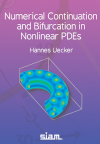- About MAA
- Membership
- MAA Publications
- Periodicals
- Blogs
- MAA Book Series
- MAA Press (an imprint of the AMS)
- MAA Notes
- MAA Reviews
- Mathematical Communication
- Information for Libraries
- Author Resources
- Advertise with MAA
- Meetings
- Competitions
- Programs
- Communities
- MAA Sections
- SIGMAA
- MAA Connect
- Students
- MAA Awards
- Awards Booklets
- Writing Awards
- Teaching Awards
- Service Awards
- Research Awards
- Lecture Awards
- Putnam Competition Individual and Team Winners
- D. E. Shaw Group AMC 8 Awards & Certificates
- Maryam Mirzakhani AMC 10 A Awards & Certificates
- Two Sigma AMC 10 B Awards & Certificates
- Jane Street AMC 12 A Awards & Certificates
- Akamai AMC 12 B Awards & Certificates
- High School Teachers
- News
You are here
Numerical Continuation and Bifurcation in Nonlinear PDEs

Publisher:
SIAM
Publication Date:
2021
Number of Pages:
364
Format:
Paperback
Price:
89.00
ISBN:
978-1-611976-60-1
Category:
Monograph
[Reviewed by , on ]
Bill Satzer
11/1/2021
This book describes numerical methods for nonlinear partial differential equations (PDEs). It largely concentrates on numerical continuation and bifurcation of solutions, and most of it centers around the use of a MATLAB package (pde2path). This software uses finite element methods for spatial discretization in conjunction with numerical continuation and bifurcation techniques.
Nonlinear PDEs can be intimidating, especially when one is faced with solving them numerically and simultaneously dealing with both bifurcations and continuation of solutions. The author tries to guide the reader into the subject, but that’s a difficult task. Even readers who are comfortable with the basics of nonlinear PDEs will find challenges here.
The first part of the book provides theoretical background, and the remainder looks at applications to a collection of model problems - all of them in the context of using the pde2path software. The author’s particular focus is to characterize solutions of nonlinear PDEs as functions of parameters with the goal of determining as much as possible about the set of all solutions. In so doing he wants to be able to trace branches of solutions through parameter space numerically, to attempt to find points where other branches bifurcate, and then to switch to the bifurcation branches and develop bifurcation diagrams. Along the way, he wants to be able to identify numerically stable solutions since these are the ones of most interest in real applications.
In the second part the focus turns to the use of the pde2path software in applications. Six applications are presented in detail. The first one discusses the quadratic-cubic-quintic Allen-Cahn equation\( \partial_{t}u= \lambda u + \alpha u^{2} + \beta u^{3} - \gamma u^{5} \) and some of its variations in one, two and three dimensions, and with several different boundary conditions. This is an example of a reaction-diffusion equation. It arises, for example, in modeling the phase separation of alloy systems with many components.
The author uses this application to illustrate basic ideas of numerical continuation and bifurcation, and to present the ideas of fold point, branch point continuation, handling of symmetries and adaptive mesh refinement. It is also an opportunity for the readers’ first test drive of the pde2path software. From there the author moves on to the Hopf bifurcation in Ginzburg-Landau models, pattern formation, and optimal control applications.
For readers equipped with a background in the numerical solution of nonlinear PDEs and some experience with bifurcations, this book would be a very useful tool in learning to use the pde3path software effectively. The pde2path software appears to be the tool of first choice for people active in this field. For readers not so experienced, the author does provide useful background material in the early chapters, but many would likely find the book rather difficult.
Bill Satzer (bsatzer@gmail.com), now retired from 3M Company, spent most of his career as a mathematician working in industry on a variety of applications. He did his PhD work in dynamical systems and celestial mechanics.
See the publisher's website.
- Log in to post comments




